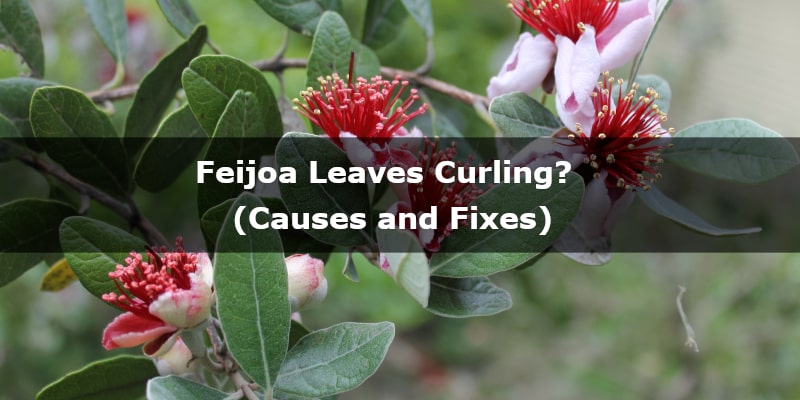If your Feijoa leaves are curling, there needs something wrong.
However, in this article, I’ll tell you all the possible causes, and how you can revive your plant.
Why are Feijoa Leaves Curling?
There are many reasons behind curling feijoa leaves. However, the most possible ones are improper watering, transplant shock, or not enough sunlight.
There can be 5 reasons why your feijoa leaves are curling. In the beginning, I’d exclude pests, and disease problems, because this plant is highly resistant to that.
It’s possible that you are overwatering, or underwatering your plant since feijoa is sensitive when it comes to water. If you’ve recently transplanted the tree, there can also be a transplant shock problem that lasts a couple of days, but you can revive the plant quickly. It’s also possible that the leaves are curling because the plant is in the wrong place.
Keep reading the articles to find out the exact reason, and learn how to fix it.
Improper Watering
One of the most common reasons why feijoa leaves are curling is the lack of water. Not enough water causes stress on the tree, and makes the leaves curly. If watered properly, feijoa tree grows taller, has more flowers, healthy leaves, and lots of fruits.
Feijoa is a thirsty plant. If you want to fix curling leaves, you should water the plant frequently, deeply, and keep the soil moist. You should keep an eye on your feijoa and water it whenever the soil is getting dry. The frequency of watering depends on the humidity and temperature. If it’s dry and warm, you should water your plant more frequently, and not let the soil dry out.
If you don’t underwater your feijoa, there might be an overwatering issue. Overwatering causes leaves to turn yellow, drop, and curl. That happens, because feijoa can’t handle excessive water in the soil. Sometimes you might not be aware of it, and you can accidentally water the plant.
If you think overwatering might be the reason behind curling leaves, don’t water the plant for the next 3-4 days, and see if it’s reviving. If you don’t want to overwater your feijoa, make sure that whenever you water it, you don’t let the soil sit in the puddle.
But proper drainage is even more important. If you keep the tree in the pot, make sure it has drainage holes at the bottom, so the soil drains and partly dries before the next irrigation. If you keep the feijoa in the ground, it should grow in well-drained soil.
Related: Can You Eat the Skin of Feijoas? Is it Good?
Transplant Shock
If you buy a feijoa seedling and transplant it to a new container, or into the ground, it is pretty common that the plant might experience transplant shock. The signs of transplant shock include wilting leaves, yellowing, and leaf rolling or curling. If the plant has transplant shock, you must have either disturbed the root, or not watered the plant properly before and after the procedure.
In order to fix the issue with transplant shock, you should be patient first. Keep the soil well watered, but make sure the plant has good drainage and is not in standing water. Moreover, you can use a sugar and water solution. When given to a plant after transplanting, this can help recovery time for transplant shock. It can also be used as a transplant shock preventative if applied at the time of transplanting.
Don’t apply any fertilizer yet and just observe the tree day by day. The tree should come back to normal after 3-5 days.
Not Enough Sunlight
Feijoa is a plant that loves the sun. It does best in full sun, or partial shade. If it doesn’t get enough sunlight, you should observe signs like leaves turning to pale green, or yellow, leaves dropping off, and curling. Also, the production of leaves will be stunted.
To fix this problem, just find a sunny place for your feijoa where it gets at least 6 hours of sunlight per day. Pick a place where no other taller plants will take away the sunlight. If you keep the plant at home, make sure it’s as close to the window as possible. After a few days, the leaves should be rejuvenated.
Root Damage
Root damage is related to overwatering. If you overwater your plant regularly, there’s a high chance that the root will eventually rot. Too much water in the soil decays the root, and in the effect, the root loses its function to transport water and nutrients to the tree. The whole tree might be affected, and it will be visible on leaves that will stop growing, and start to curl.
Prevention is easy. You just need to provide good drainage, and not overwater the tree. However, if you’ve already damaged the root, you can still save it by replanting in fresh soil with good drainage, if some healthy, white, firm roots exist. If the damage is more advanced, there is no way you can save your feijoa.
Not Enough Fertilization
Feijoas require regular fertilization. If not, the growth of the tree will be slow, the plant will be weak, and the leaves will turn yellow, and start curling.
If you want to grow a healthy feijoa, you should apply a proper fertilizer once every 2 months during the growing season. I’d recommend an 8-8-8 fertilizer, like this one on Amazon to get large, high-quality fruit and healthy growth.
Sources
rocketsgarden.com, progardensupply.com, homeguides.sfgate.com

